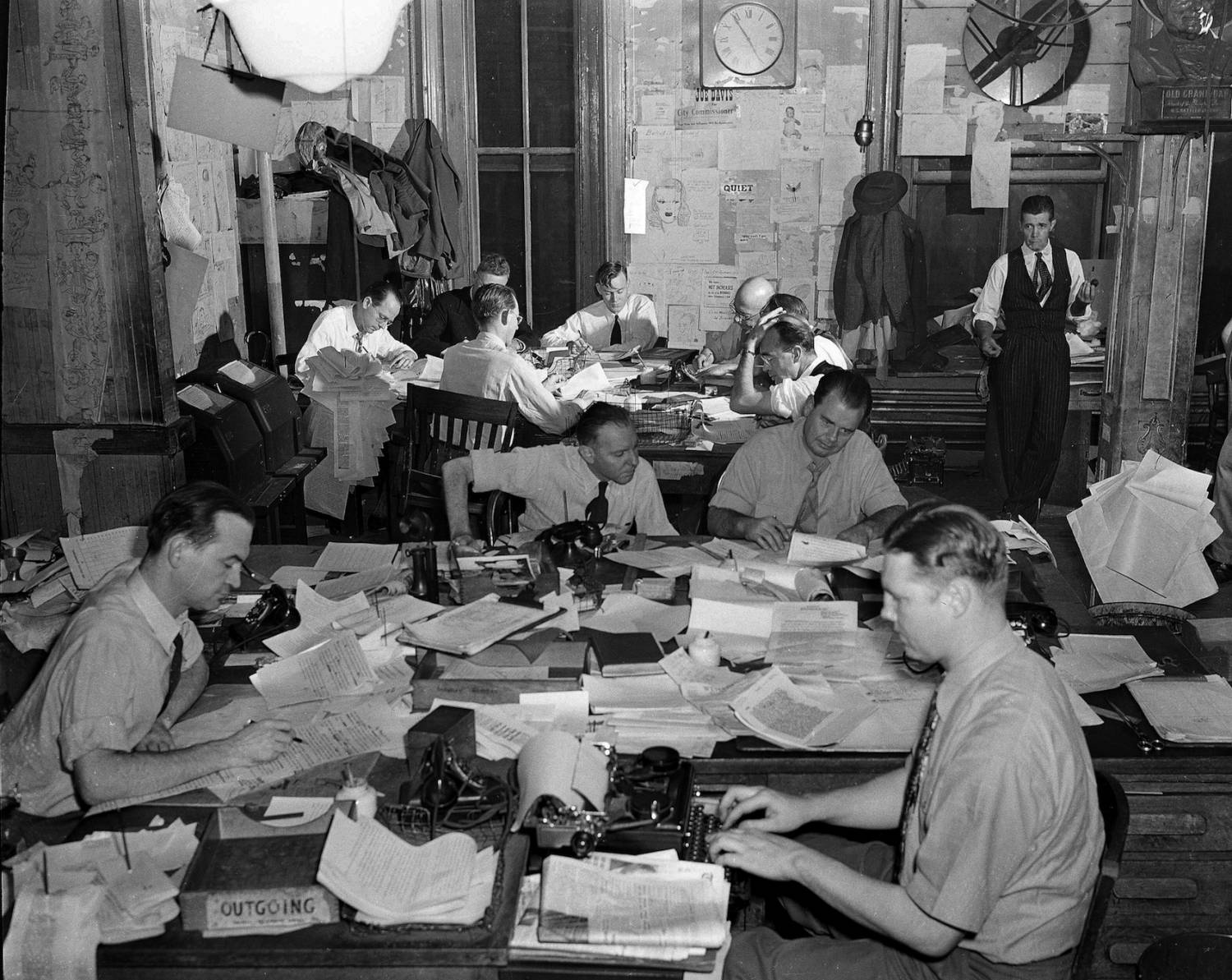Two decades ago, I wrote a critical essay titled “Goodbye Copy Desks, Hello Trouble.” What prompted that Newspaper Research Journal piece was a brief experiment in eliminating free-standing copy desks – an approach taken in the mid-’90s by a few regional newspapers.
Those papers thought that moving copy editors onto reporting or production teams would solve some long-standing problems and, not incidentally, save money by realigning staff resources. Some viewed the change as a way to replace an archaic assembly-line model of news production. The approach ultimately was copied by very few papers, and some that eliminated their copy desks soon found it wise to start rebuilding them. Too many mistakes were appearing in print, and headline-writing suffered. The papers mostly abandoned the experiment, and the lessons learned have been forgotten.
With The New York Times planning to dismantle its free-standing copy desk, it’s a good time to remember them. Do the questions remain valid today? Do they point to what The Times risks by implementing this plan?
Related Training: ACES In-Depth Editing Online Group Seminar (September 2017)
The Times’ idea is to reduce its 100-plus-person copy editing staff by reassigning some into a hybrid role – “strong editors” who will be expected to handle both assigning and copy editing duties. The rest will lose their jobs, either through buyouts or layoffs. How many will be reassigned remains unclear.
The copy editors understandably were hurt and angry. They agree that change is necessary, but they say they’re ready and willing to adapt. According to a letter they wrote to Executive Editor Dean Baquet and Managing Editor Joe Kahn, the company insultingly views much of what they do as “low-value editing” and the decision to eliminate the free-standing desk “betrays a stunning lack of knowledge” of what copy editors do. Reporters agreed, sending their own letter to management. The reporters said that the plan “is ill-conceived and unwise, and will damage the quality of our product. It will make us sloppier, more error-prone.”
Baquet responded in a July 6 column about the decision, telling readers that the paper is not eliminating its free-standing copy desks to save money, nor, he said, is it eliminating copy editing. He said the paper needs to reduce its longstanding system of layers of editing, which was created for a print era. “Our goal with these changes is to still have more than one set of eyes on a story, but not three or four,” he wrote. “We have to streamline that system and move faster in the digital age.” The Times “will use the savings from these cuts to bring in more reporters and other journalists who can build a report that acknowledges the changing world of journalism,” Baquet said.
Indeed, it is a different era. In the mid- to late ’90s, the internet as a journalistic medium was barely out of diapers. Print advertising revenue was still fairly strong, though significant cracks were appearing in the revenue façade. Newspapers were only a few years into the modern era of staff purges.
The big issue for newspaper copy editing and production in the late ’80s and early ’90s was pagination, computer-based page production that we now take for granted. The concern, felt most at the time by copy editors, was whether one really couldn’t do more with less. In fact, they knew that they couldn’t even produce at the same level of quality if they had to take on the additional work of putting pages together on a computer screen.
Around this time, a variety of experiments in newsroom organization arose, including the move to eliminate free-standing copy desks at papers like the Wichita Eagle and Minneapolis Star Tribune. The implementation differed a bit by newspaper, but the general idea was based on several beliefs:
- That story editing would be improved if copy editors developed content-based expertise by working closely with reporters and assigning editors in topic teams rather than on free-standing desks.
- That morale would improve – longstanding tensions between copy editors and reporters could be eased if not eliminated.
- That reporters could and should self-edit better (and maybe even write their own headlines).
This mid-’90s experiment wasn’t quite the same approach as the Times is proposing, but it’s close enough to raise similar questions. The change did lead to some easing of staff tensions, but the downside was too great. Among the concerns I raised in 1998:
Would elimination of the copy desk as an entity lead to a loss of editing expertise? Would quality suffer, because less is not more when one is faced with additional tasks? Perhaps most critically, would newspapers lose a critical independent eye on stories before publication?
Baquet insists that eliminating the copy desk will not eliminate copy editing. But what will remain? What does a free-standing desk do that the proposed restructuring will struggle – and likely fail – to accomplish?
The expertise issue. Copy editing, assigning desk editing and reporting draw on different skill sets. Reporting involves getting the story, sourcing, organizing and writing. Assigning desk editors work closely with reporters, focusing on the story at a macro level, its focus, completeness and organization. Copy editors pay strict attention to the detail level – the mechanics of writing, clarity and style, as well as accuracy. They also provide a crucial level of review on broader issues such as structure, fairness and libel, and they write crisp, accurate headlines. This division of labor may seem puzzling to the uninitiated, but it has been applied successfully for more than a century, especially at larger papers. Smaller papers often blur those lines, but they wouldn’t if they had greater resources. Some reporters are good editors, but most aren’t. It’s no surprise that the Times reporters wrote an impassioned plea to save the copy desk. Some assigning editors are good copy editors, but they have other tasks that will necessarily take priority. This can compromise expertise and lead to…
The quality issue. The lesson from pagination applies today – when you have too many things to do, you cut corners. When you cut corners, you cut quality. The concern I raised in the ’90s was that copy editing would be compromised when editors had to prioritize production. A similar concern about doing more with less exists today. An assigning editor – a “backfielder” in New York Times parlance – is likely to favor the story-shaping role and pay less attention to the detail-level editing, even if he or she has been a copy editor. It’s difficult to not see quality suffer, and it’s puzzling that top management doesn’t seem to acknowledge it. Their claim about creating a “strong editing” system seems a bit Orwellian.
The independence issue. Has anything in the digital world changed to make an independent copy desk passé? One could argue that an independent eye on stories before publication is more important today when the safety net is shredded because of earlier staff cuts and a chief executive is willing to wage a Twitter war on any real or imagined factual issue. Copy editors add considerable value to the news precisely because they are independent. They represent the readers, and they watch out for the organization’s reputation. Sometimes, perhaps oftentimes, this independence leads to disagreement or even outright conflict with reporters or assigning editors. But the result is an improved story – one where tough questions are asked and answered.
Other problems emerged 20 years ago. For example, headline-writing suffered. A free-standing copy desk is designed to produce good headlines in part because critique is built into the slot-rim structure. A paper such as the Times has highly experienced copy editors, but I’d bet half of the headlines published in the Times have been tweaked, massaged or rewritten because of a copy chief’s critique. The result, unsurprisingly, is better headlines, and ultimately better headline-writers.
Why does any of this matter? The New York Times is just one paper, albeit a highly regarded one, and if this restructuring is a mistake, so what?
It matters because quality matters. Commenters on Baquet’s Q&A column worried that editorial quality would be compromised. One wrote, in part:
“Over and over in the reader comments below, I’m seeing the same thing: that readers DON’T USE THE New York TIMES FOR VIDEO! We want to read, and we want to read well-written, well-edited journalism. … Please reconsider your direction.”
A more subtle issue is internal. A free-standing copy desk demonstrates that copy editing is valued. Eliminating a free-standing desk, as Baquet says, may not eliminate copy editing, but it will surely weaken it in the eyes of the rest of the staff.
To the rest of the U.S. journalism world, the NYT is a bellwether. It is one of a tiny handful of U.S. newspapers widely known for top-tier copy editing. Other newspapers look to the Times for ideas – about news judgment, multimedia innovation or staff organization. One danger in the Times’ plan is that other newspapers will say, if it’s good enough for one of the world’s greatest newspapers, why not for us? It may be unfair to say The New York Times has a responsibility to journalism not to make big mistakes. But the paper can’t have it both ways – to bask in its reputation, which it likes to do, and to take actions that threaten its quality.
The bottom line is that this experiment is likely to fail because, despite Baquet’s assertions, the demands of the digital era do not make a free-standing copy desk obsolete. Not if quality matters. It may cost money, but it’s money well-spent. And if the plan does fail, it will be difficult to restore a top-notch copy desk. As papers learned in the ’90s, it’s a lot easier to dismantle a copy desk than to rebuild one.






